#linux assignment help
Explore tagged Tumblr posts
Text
Linux Assignment Help
Linux Assignment Help is very important for students who are facing challenges in their lengthy Linux assignments. Operating systems are the main subjects in programming courses. Linux is the most largely used open-source Operating System. It is very important to have knowledge about all basic concepts in Linux to achieve high grades in your assignments. Therefore, Gradespire provides assistance to the best writers to complete your Linux assignments. They will help you in completing your assignment work before the given deadline. Our assignment writing services are available at very reasonable prices. So let’s ensure your academic success with Gradespire!
0 notes
Text

Linux Assignment Help: Navigating the Open-Source World
Linux, as an open-source operating system, has become a cornerstone of modern computing. Its versatility, security, and robustness have made it the preferred choice for many, from individual enthusiasts to large enterprises. However, delving into Linux assignments can be a challenging endeavor, as they often involve intricate tasks related to system administration, shell scripting, and network configuration. This is where Linux assignment help steps in as an invaluable resource.
Linux assignment help services are designed to assist students and professionals in mastering the complexities of Linux. They offer expert guidance on various topics, such as file system management, user permissions, process control, and troubleshooting. Whether you're a beginner trying to grasp the basics or an advanced user tackling complex tasks like kernel customization, these services provide tailored solutions to meet your specific needs.
0 notes
Text
Linux Assignment Help On A Budget: 9 Tips From The Great Depression

Introduction
In the world of technology and computer science, Linux is a widely used and revered operating system. However, as students navigate their way through the complex world of Linux assignments and projects, they often find themselves in need of assistance. The challenge is, of course, finding this help within a tight budget. Fortunately, just like the resourcefulness displayed during the Great Depression, thee are ways to get Linux assignment help without breaking the bank. In this article, we’ll explore nine tips inspired by the resilience of the Great Depression era to help you get the Linux assignment help you need without overspending.
Utilize Online Resources
During the Great Depression, people had to rely on the resources available to them. Similarly, in the digital age, there are numerous online resources available for Linux learners. Websites, forums, and blogs are treasure troves of information and can provide valuable insights into Linux topics. Websites like Stack Overflow, GitHub, and Linux forums are excellent places to seek answers to your Linux assignment questions.
Leverage Open-Source Tools
Just as people had to be resourceful and make the most of what they had during the Great Depression, Linux users can take advantage of open-source software. Linux itself is an open-source operating system, and there are plenty of open-source tools and applications available for various tasks. Tools like LibreOffice, GIMP, and VLC can be used for office tasks, image editing, and multimedia playback, respectively, without spending a dime.
Explore Free Online Courses
The Great Depression forced people to seek out opportunities for self-improvement, often without spending money. Similarly, there are numerous free online courses and tutorials that can help you enhance your Linux skills. Platforms like Coursera, edX, and Khan Academy offer free courses on Linux and related subjects, allowing you to gain knowledge and expertise without emptying your wallet.
Join Online Communities
Communities played a significant role during the Great Depression, providing support and sharing resources. Similarly, joining online Linux communities can be immensely helpful. Communities like the Linux Users’ Group (LUG) can connect you with experienced Linux enthusiasts who are often willing to provide guidance and assistance with your assignments.
Utilize Free Textbooks and Documentation
Access to educational materials was limited during the Great Depression, but today, you can find free textbooks and documentation for Linux and related subjects. Websites like the Linux Documentation Project (LDP) and the Ubuntu documentation site offer comprehensive guides and manuals that cover a wide range of topics. These resources can be invaluable when you’re working on Linux assignments.
Use Virtualization for Experimentation
During the Great Depression, people had to be creative with the resources they had. In the world of Linux, virtualization can be your budget-friendly friend. Virtual machines (VMs) and tools like VirtualBox or VMware Player allow you to create and run multiple Linux environments on a single physical machine. This can be incredibly useful for testing and experimenting with different Linux setups without the need for additional hardware.
Consider Freelance Assistance
If you find yourself in need of more personalized Linux assignment help, consider hiring a freelance expert. Many talented Linux professionals offer their services on platforms like Upwork and Freelancer. By setting a reasonable budget and clearly defining your project requirements, you can find a freelancer who can assist you at an affordable rate.
Explore Educational Discounts
During tough times like the Great Depression, people sought discounts and deals wherever possible. Similarly, as a student, you can explore educational discounts on software and services related to Linux. Companies like JetBrains offer discounts to students, making it more affordable to access developer tools like IntelliJ IDEA and PyCharm.
Contribute to Open Source Projects
In the spirit of community and collaboration, consider contributing to open-source projects. This not only allows you to gain hands-on experience but also opens doors to networking with experienced Linux developers who may be willing to provide guidance and support. Remember, the Great Depression era also saw people coming together to support one another, and the open-source community embodies this same ethos.
Conclusion
Just as the Great Depression forced individuals to be resourceful and creative in their pursuit of a better life, Linux users can employ a similar mindset when seeking Linux assignment help form myassignmenthelp.com on a budget. By utilizing online resources, open-source tools, free courses, online communities, and other cost-effective strategies, you can acquire the assistance you need without straining your finances. Remember, Linux itself embodies the principles of openness, collaboration, and resourcefulness, making it an ideal choice for those seeking to learn and grow within budgetary constraints.
Original Source: https://forum.linuxcnc.org/cb-profile/pluginclass/cbblogs?action=blogs&func=show&id=6240
0 notes
Text
im disgusted with myself but im going to have to learn how to operate linux, my worst nightmare has come true
#it’s not that i hate linux#i just can’t seem to remember commands#or how to make them work together#i dont think it helps that i got TRAUMATIZED by a teacher#he used to give us graded assignements during class#they lasted hours#and we had to install servers and such with commands we didn’t even learn#he gave us youtube tutorials#results: i didn’t learn shit#and now im lost at work lmao#like i know i don’t need to learn but i feel like i kind of do
0 notes
Text
helpful (free) utility programs for artists
Allusion
reference image organizer. shows all the images in any folders you assign it to look in, and provides an easy interface for tagging and searching them. you can nest tags within each other, and when you apply a tag to an image it also applies all the parent tags. so if you tag 'tank top', and tank top is in the 'shirt' tag, it'll include that image when you search 'shirt'. also open source!
compatible with windows, mac, and linux

Pureref
reference image viewer. can create reference image collages, add notes, lock the window to stay on top, set the window to be partially transparent, and save 'scenes' so you can quickly pull up whatever character ref you need without searching for all your references images and re-adding them every time. supports loading images from file and copy-pasting from web.
compatible with windows, mac, and linux
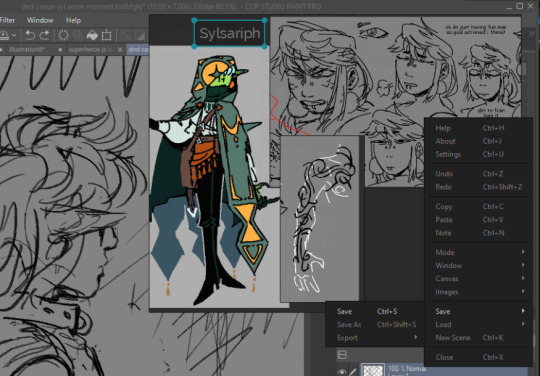
WhatColor
color describer. shows you details about the color your mouse is over. it's designed for colorblind folks, and I mostly use it because I have strong color filters on my screen 90% of the time for health reasons. however it's also helpful when you're learning to dissect color palettes and are trying to see how the perception of a certain color is affected by the colors surrounding it. use it to see how often ur brain gets duped into seeing purple when it's actually blue
compatible with windows 7/8/10
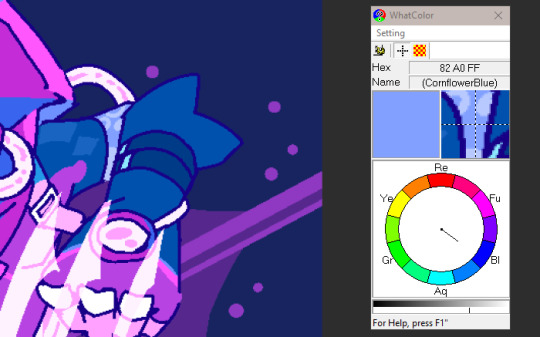
#talking#ngl made this mostly bc i found allusion a couple days ago and i'm still living off the hype of finding it#also cause not enough ppl know abt pureref#whatcolor isn't specifically an art tool but i think it's useful as one
625 notes
·
View notes
Text
Your Blade, My Heart (Full Release)
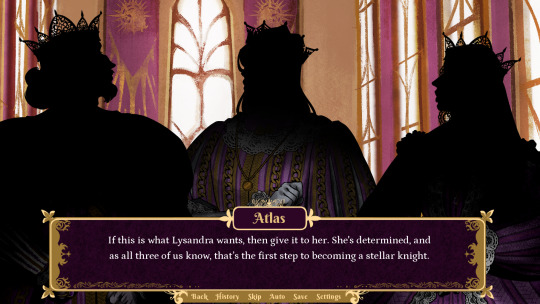



"My future. My heart and soul. My everything."
Story
Despite being a member of royal family Solstice, you were never destined for greatness. Instead, that honor was given to the next in line for the throne: your brother, Atlas. Feelings of jealously, inferiority, and anxiety grew as years past, until they became too much to bear. Wanting to prove yourself, you aim to become a knight in the Dominion of Solis' capital city's army.
However, with no prior combat experience, your Father assigns the best knight to train you: Grand Knight Ramon Dayore. He's a stoic man who's scratched and clawed his way to the top. However, his experiences have made him close off his heart.
Will you be able to open the door to his heart, and help him love again?
Content Warning
Due to the sexual content featured in this title, Your Blade, My Heart is meant for players 18 years or older.
This game also contains the following content...
Anxiety and panic attacks
Mentions of death
Grief
Features
💜 40k words
💜 Option to self-insert or play as the canon protagonist, Princess Lysandra Solstice (She/Her)
💜 Name input, pronoun selection, select body type, select everyday attire (feminine, masculine, gender ambiguous) and the history behind that
💜 A lot of flavor choices! Seriously, this is what happens when you're a writer hopped up on Dr Pepper...
💜 Determine the intimacy scene you have with Ramon! Spicy fade to black where you're on top or bottom, or a fluffy cuddle session~
💜 Accessibility options (Font selection, Shakescreen toggle, self-voicing toggle, image and sound captions)
💜 Original soundtrack
💜 6 CGs (+2 cut-ins) with the option to unlock the spicy intimacy CGs if you decide to choose the cuddle/fluff intimacy scene first! This is for anyone who may be sex-repulsed or is just uncomfortable with those kinds of scenes!
💜 A very handsome demisexual knight and a cute slowburn romance story written by an asexual woman :3
You can download the game right now on PC, Linux, Mac, and Android from itchio!

#english visual novel#visual novel#indie game#my games#interactive fiction#indie otome#amare#otome#your blade my heart#ybmh
48 notes
·
View notes
Text
Ok this is a bit of a wordy post but bear with me. I've been reading up on the tech literacy discourse and I thought I'd add my two cents, and how it connects to piracy. LONG post under the cut!
I was born in the year 2000, which puts me on the border of being a digital native. I was brought up on tech, but only in my later childhood and teens. I've always considered myself "tech literate," but no more than the usual kid my age.
The first time I ever truly experienced tech illiteracy with my peers was when I was 23, when in one of my college classes a MacOS update rendered the software we used for said class unusable. After a few days a temporary patch was released, which by that point an assignment that utilized the software was due the next day. I followed the patch instructions, which involved navigating to the software files and substituting a designated file with the provided patch. A bit more complicated than a simple update, but the instructions were clear and intuitive enough to easily understand where the file went. The next day, during a class study session, I overheard multiple people come up to the professor complaining that the software wasn't working. After the second person complained with the professor being clueless, I asked the student what MacOS version they were on. Sure enough they were on the latest version, which as we already know is incompatible with the software. I then walked the student through the patching process step-by-step, with them needing to essentially be hand held through the entire process (almost to the point of me doing everything for them). After the patch was implemented, the student thanked me and said "Wow! How did you figure all of this out?" and to me that question was stupid- I just googled "[software] [version] MacOS [version] fix", went to the first result (which was the company website), downloaded the patch zip file, and followed the instructions on the README.txt file. It was so easy, and I couldn't comprehend that this was somehow complicated for other people, especially those my age. I mean we literally grew up using computers. It wasn't until I started learning about tech literacy and learned helplessness that I finally started connecting the dots.
Tech in general is becoming extremely user friendly, almost to a fault. UI and UX simplicity is taking away any critical thinking needed to use any sort of tech. My peers are so used to one-click and/or automatic updates, so the fact that this required slightly more effort than a simple update triggered their learned helplessness. The professor was no help in this case either, since he just extended the due date for those affected with no penalty. I actually ended up making a very detailed (and I mean idiot proof detailed) step by step picture guide with screenshots on how to install the patch for the software for the class. Anyways, back to the main point- How can I blame my peers for not knowing how to install a "complicated" update when they're so used to being spoon-fed simplicity?
But hang on- how was I the exception? I'm just as used to tech simplicity as anyone else, it's not like I'm using anything differently or making things harder for myself on purpose (I'm looking at you, linux users). So why was I the only one who knew how to install this update? It wasn't until I had a discussion many months later with my mom about this tech illiteracy epidemic that I finally thought it through. I acquired problem solving skills through piracy. To start off: not piracy but adjacent- learning to install mods in Minecraft when I was 11 taught me file navigation and what a README.txt file was, as well as the importance of version specificity/compatibility. Figuring out how to play Pokemon roms on the family computer and my iPod touch when I was 12? That's piracy, and it also taught me how to work with different platforms and the art of jailbreaking. Installing custom firmware on my 3ds so I could pirate games when I was 16 taught me how to follow written tech instructions without any visual guidance. Pirating Adobe software on my MacBook in high school taught me about patching files on MacOS. All of this knowledge and inherent googling that came with it made installing the patch for my class software look like a tiny drop in the bucket in terms of complexity.
So why am I saying all of this? Am I suggesting people learn to pirate to become tech literate?
yes.
With everything becoming pay-walled, subscription services running rampant, the proliferation of closed-source "ecosystems" *cough* Apple *cough*, and (arguably) most importantly media preservation, piracy is a skill that will serve you well in the long term. It will teach you critical thinking in the tech sphere, and if enough people learn then we can solve this ever growing epidemic of tech illiteracy. I'm not really sure how to end this post, so if anyone has anything else they'd like to add please feel free to.
Thank you for coming to my ted talk.
43 notes
·
View notes
Text

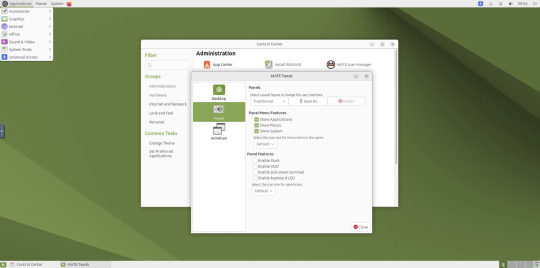
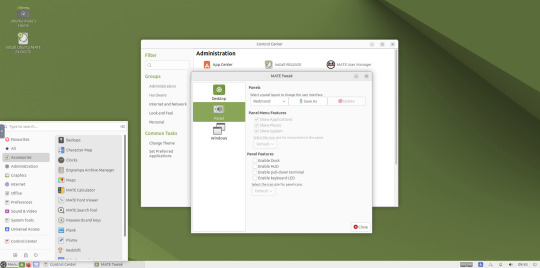
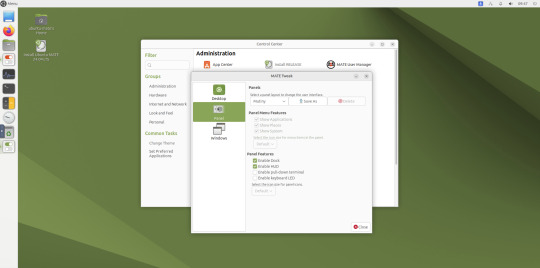
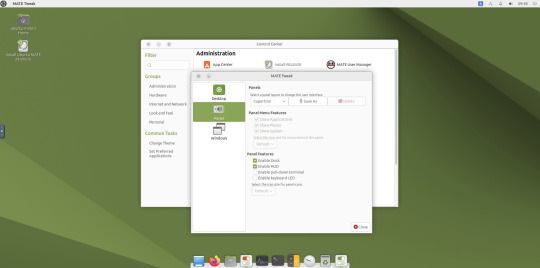
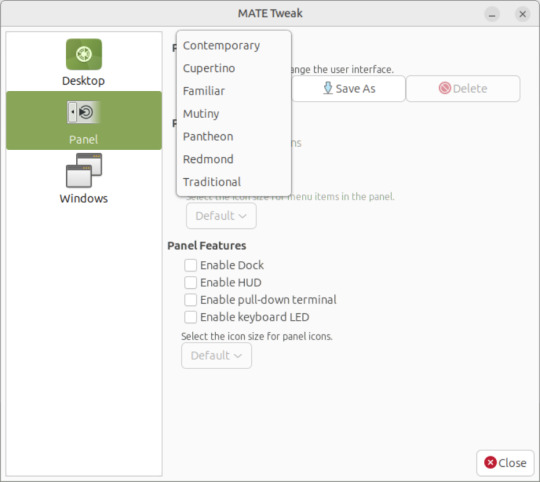
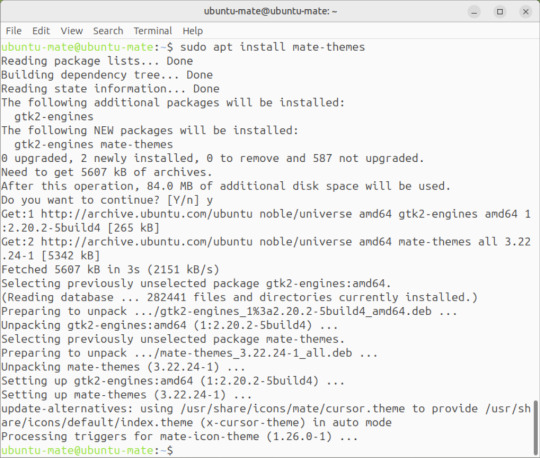

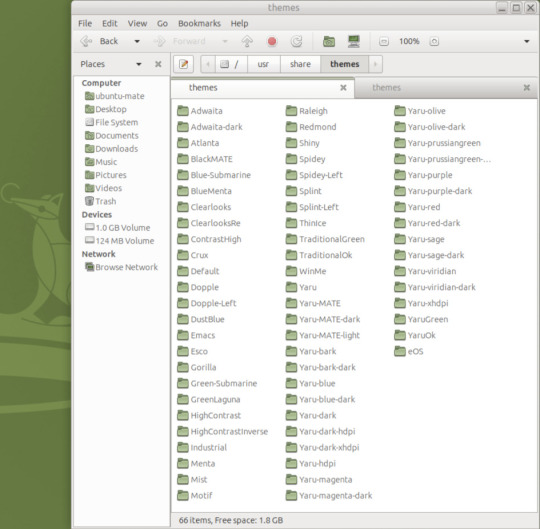
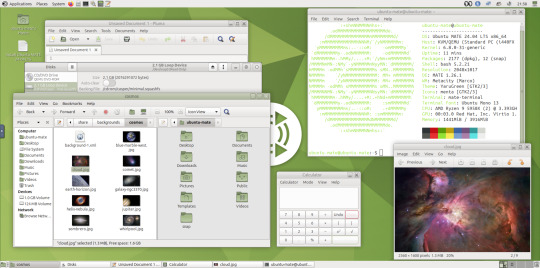
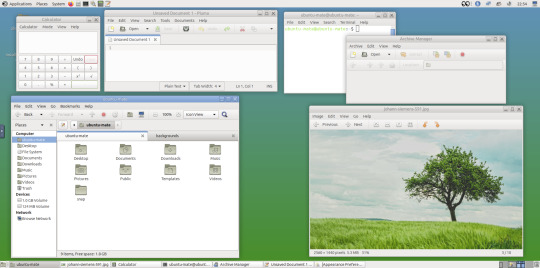
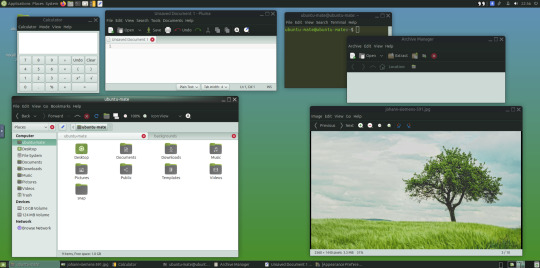
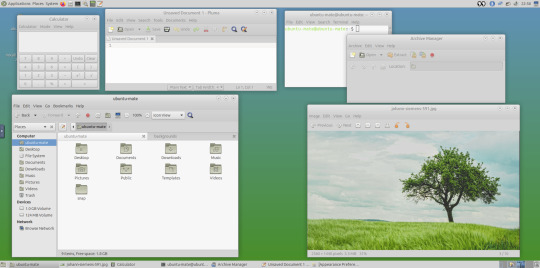
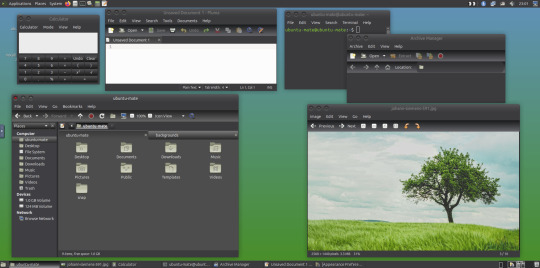

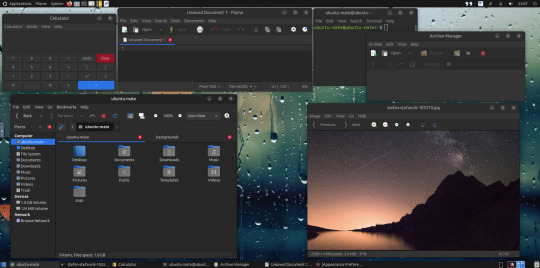

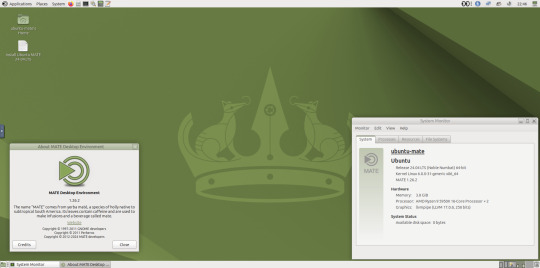

May 2025.
I tried installing a set of themes on Ubuntu MATE 24.04.1 LTS in Distrosea today.
https://distrosea.com/
These themes are provided as a theme package found in vanilla MATE desktops such as Debian and Fedora.
MATE is the modern day continuation of GNOME 2, a very popular, efficient and functional desktop environment from the early 2000s.
The theme pack I selected are compactable GTK3/4 (Graphical Toolkit) versions based on classic GNOME 2 era themes.
Ubuntu MATE website:
https://ubuntu-mate.org/
Debian Linux website:
https://www.debian.org/
Fedora Linux website:
https://fedoraproject.org/spins/mate
See MATE Desktop website here:
https://mate-desktop.org/blog/
About the Graphical Toolkit user interface:
https://en.wikipedia.org/wiki/GTK
I used the MATE Tweak tool to adjust the panels from the 'familiar' layout to the 'traditional' layout. Here are many of the layouts available.
MATE Tweak can change the panel layout between Traditional (GNOME 2), Unity, Redmond (Windows) contemporary (Mac OS) style.
Here are many of the layouts available.
Afterwards, I used the command line to install the themes with the command: sudo apt install mate-themes.
This command then prompted me to agree the system changes and then it installed the required theme files to the list.
I opened up the theme folder in the Caja file manager. This shows all the ones installed on the system.
Next I opened the appearance preferences and cycled through each theme. There are a total of 12 new themes it added alongside the existing Yaru Colour theme collection for Ubuntu.
This package couldn't be installed graphical so this is why I installed it through the terminal. It is also available to install through the Software Manager on Linux Mint.
The theme package can also be installed on the Cinnamon desktop and other linux distributions.
I like these themes as they provide a more 3D feel and is refreshing to see themes for a desktop environment that hasn't moved towards flat design. It themes all the desktop elements from the windows, panels, drop down menus, CSD apps and widgets.
My favourite one is called YaruOK (blue), as it provides resizable window controls, 3D controls and provides a familiar look to the desktop. The theme is also called TraditionalOK.
This theme is a fork of a GTK2 theme called Clear-looks, which was created by Red Hat developers.
YaruOK is a modern variant that uses GTK3 & 4. The theme is rendered in SVG instead of PNG format which improves HiDpi scaling and features themed client side decorations for header bar windows such as the Disks utility.
I also added a GNOME Eyes widget onto the panel!
These fun set of eyes follow your mouse cursor around the screen and can help you find the cursor amongst the clutter of windows. It is built to be very lightweight.
I also like the workspace switcher on the bottom left, which allows you to switch between as many desktop workspaces as you want.
The little square windows within each desktop can be clicked on and moved to another workspace.
Like with other desktop environments, you can also right click a window and move it onto another workspace. Each desktop can be named for a assigned task.
A System Monitor widget can also be added to the panels to display CPU, Memory, Swap and Network processes.
There are many other very interesting widget to play around with on the desktop and panels as well!
Here are the MATE themes in Ubuntu Linux 24.04.1, integrating with the Cinnamon desktop.
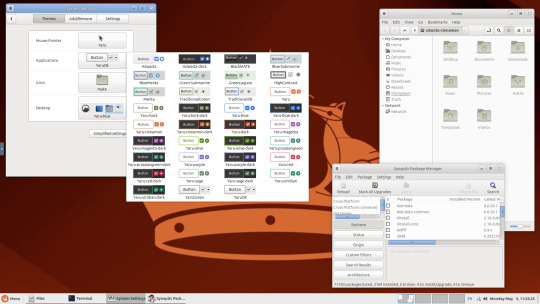
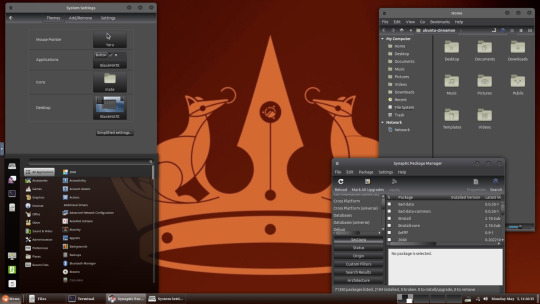
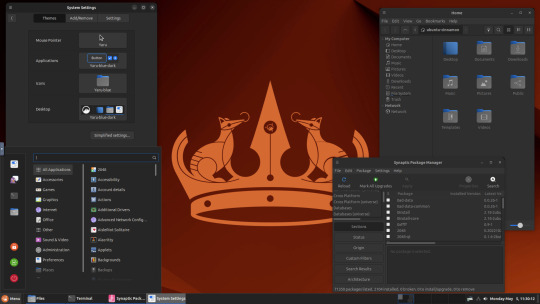
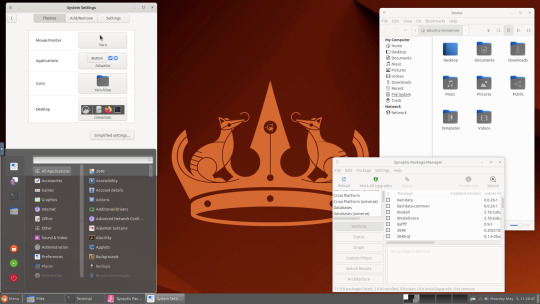
Below are some theming screenshots from Debian MATE 12 Linux.
I've customised the panel, selected the compact menu and changed notification sizes to make it more clearer. The window lists stack onto each other with the increased size.
The MATE panels have adjustable transparency and can be re-coloured and textured very easily through its own preferences box.
See screenshots below!
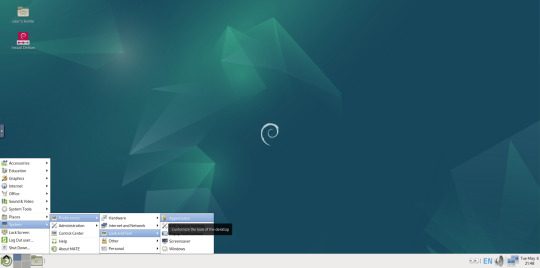
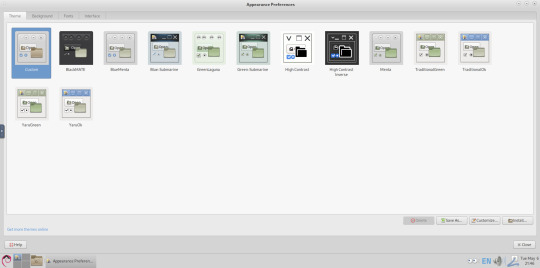
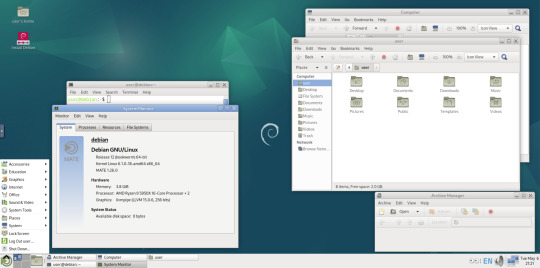
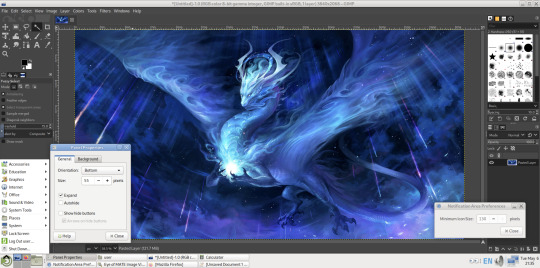
A very interesting look at the user interface elements found in GNOME 2, MATE and Cinnamon Linux desktop environments!
5 notes
·
View notes
Text
Dwarf Fortress 50.10 Released
Toady One, on the Bay 12 Games forum:
Download (Click refresh on your browser if it doesn't show up) Release notes for 50.10 (September 19, 2023): Linux version is up! New stuff (*) Can view all alerts, including old ones that have been dismissed (*) Can view combat reports from creature sheets (*) Can pause combat reports whenever new events are added (*) Added crash logging Major bug fixes (*) Fixed crash from removing zone with assigned unit (*) Fixed multithreading crash related to announcements (*) Fixed a potential crash issue with monarch arrival and made them provide more wagons properly (*) Fixed potential crash related to certain traveling creatures (*) Ammo assignments are updated properly when changing uniforms (*) Removed ownership of food items whenever they are dropped (stops rotten food hoarding in rooms) Graphics additions/changes (*) New stone ramp graphics Other bug fixes/tweaks (*) Made creatures more able to get out of trees (*) Sped up mid-level map retrieval (helps slowdowns on large world embarks) (*) Optimized relationship lookup for socializing dwarves (*) Fixed out of bounds issue with wheelbarrows (*) Stopped music mods from throwing error when making a new world (*) Fixed crash when there's an invalid language (mods) (*) Made broker leave depot when last wagon leaves instead of first
20 notes
·
View notes
Text
In a strange twist of events that 99% of pc users will never encounter it's looking more and more like I'm actually going to have to DOWNGRADE my cpu.
No matter what I do I CANNOT get the temps down. I've cleaned the vents, cleaned the fan, repasted with the best stuff I could find, changed the power settings, disabled turbo boost, looked into tpFanControl but backing out since it has the potential to brick my BIOS (hasn't been tested to work with my model. Maybe when this isn't my only decent pc), trying lenovo's heat management utilities (vantage was extremely unhelpful and the older versions won't install on win10, they're straight up blocked by the OS despite being signed), and it STILL idles at 80°c at night while only having the hardware monitor open (and maybe doing a maintenance scan in the background). Yes, it's sitting on an additional fan. Yes, I've debloated Win10 and am looking into Linux once I can afford or even find a big enough msata drive for it.
The only things I've yet to try is tinkering with the BIOS (for some reason the f key shortcut when booting doesn't work :/), brute forcing my way through the power manager install (there's a way to do it that I haven't tried yet) and hunting down the xtreme edition cpu manager that actually works (may be a dead end since the thinkpad forums mentioned that you can't unlock the cpu for tweaking). If none of that works my only options are reducing the wattage of the CPU and/or plumbing the thang into extended intake/exhaust pipes, which I can't use if I have to take it anywhere (rare, but if I have an assignment where I have to create a video it's far better at it than my other options).
Worst part is that it WASN'T always this hot, it used to max out at about 70°c, but I can't remember when I got those numbers during winter or not. Most people with this model usually ask about upgrading their CPU, but mine came with the upgraded option, so a lot of the stuff I've found online hasn't been particularly helpful. I guess on the plus side I'll actually get more than an hour on my battery alongside the better temps if I do downgrade (battery is practically flawless with less that 3% capacity loss. Doesn't matter too much since its rarely on battery anyways, I usually just treat it as a desktop with a huge UPS. It would be nice though to get through a whole movie without having to go grab the power brick in the last 25 minutes).
Was really hoping to max out the RAM and put some additional drives in it first, but I really have to deal with these temps before I cook something. Anyways, any fellow toasty thinkpad owners want to weigh in?
#thinkpad#t's computing woes#might just bite the bullet after my birthday by getting a good psu and build my first decent desktop in 11 years#i love my paving slab thinkpad; but the thermblies...#when i say my only decent pc i mean it. my other options are my surface; a winxp dell latitude and a 2005 hp compaq desktop#every day i miss my 2013 desktop that if my parents didnt chuck out i could fix today and still run old minecraft flawlessly
2 notes
·
View notes
Text

Linux assignment help provides invaluable support to students and professionals navigating the intricate world of the Linux operating system. With Linux's growing significance in various fields, including IT, programming, and server management, this service offers expert assistance in tackling complex Linux assignments. Experienced professionals and experts in Linux architecture, commands, scripting, and administration are readily available to clarify doubts, offer guidance, and provide custom solutions. Whether it's shell scripting, kernel programming, system configuration, or troubleshooting, Linux assignment help ensures that learners grasp the nuances of this open-source platform, promoting a deeper understanding and proficiency in Linux-related tasks.
0 notes
Text
DotAGE pits you against the end of the world

DotAGE survival roguelite turn-based city builder game now has a release date for Linux, Mac, and Windows PC. Thanks to Michele Pirovano's dedication and hard work, this is becoming possible. Due to make it s way onto Steam next month. DotAGE is an upcoming experience due to debut on Steam on October 4th, 2023. It’s also a unique blend of various mechanics that might remind you of playing board games with friends. The release date promises so much more to it than that. DotAGE has been a labor of love for Michele Pirovano, who has been working to create this survival roguelite turn-based city builder since 2014. As the wise elder of a small village, the end of the world is on the horizon. So of course, it's your duty to help your village residents, Pips, prepare and survive this looming disaster. DotAGE is a challenge where every decision you make has outcomes, and time is ticking. In DotAGE, you'll have to strategize on multiple fronts. From setting up your village to deciding where your workers should focus their efforts. There is a lot to plan and arrange. Want to have fresh food? Make sure you're growing crops and looking after animals. Need tools? You'll have to build a place where these can be made. There’s also the element of death; sometimes, you’ll need to oversee funerals. Due to ensure that everyone is cared for, even in their final moments.
DotAGE Gameplay Teaser
youtube
What’s unique about DotAGE is that it isn’t just about managing resources and tasks. There's also an evolving storyline that unravels the mystery behind the impending Apocalypse. Why is the end of the world coming? As the elder regains memories, you’ll uncover new aspects of the story and mechanics. Since the deeper you dive in, the more you'll discover, making each game distinct. With over 200 structures to create, 70 materials to manage, and an amazing 600 events that could happen. No two games will be the same. There's a vast scope for experimentation. Plus, as you progress, new features are unlocked, due to offer even more depth. In a nutshell, DotAGE offers an intriguing blend of strategy, decision-making, and exploration. It’s not just about building and assigning tasks; it's about delving into a world that’s ever-changing. Since every move you make is pivotal. You can try it for yourself with the Linux Demo on Steam. Keen to stay updated on the survival roguelite turn-based city builder release? You can add it to your Steam Wishlist. Coming to Linux, Mac, and Windows PC. If you're looking to dive deeper into discussions or simply want to be in the loop, follow @dotagegame on Twitter or hop into the Discord channel dedicated to it. Along with the October 4th, 2023 release date.
#dotage#survival#roguelite#city builder#linux#gaming news#Youtube#michele pirovano#ubuntu#mac#windows#pc#unity
2 notes
·
View notes
Text
Hire Unity Game Developer – Mobile, PC & VR Projects

Introduction
Before you hire a Unity developer, , it is important to understand what makes Unity create unity for the development of multiple platforms. utility of Unity - From Mobile to VR - its wide asset shop, and strong social support has made it an equal alternative for indie creators and global studios. Whether you are making a mobile puzzle, a PC RPG or a full Ive -consuming VR experience, Unity provides a harmonious ecosystem that reduces the time -which kills and reduces developmental barriers.
Why Choose Unity for Game Development?
Cross‑Platform Capabilities
When it comes to crossing the transverse platform Purinogen, the unit shines. With a single code base, developers can target the VR platforms such as iOS, Android, Windows, MacOS, Linux and even Oculus, Vive and Playstation. This flexibility means low growth costs and a wide access to your game. Don't miss the opportunity to hire unity game developers, who know how to effectively benefit the Build Pipelines of Unity for each platform.
Strong Community & Asset Store
A lively ecosystem surrounds the unity. Asset store thousands prepared by the team plugins, 3D models, VFX, shades and tools that speed up the development. Active platforms and training library developers help developers with fast troubleshooting, learning best practice and sharing knowledge - it is easy to score customized projects. When you hire Unity 3D developers, make sure they are well prepared to tap in the asset store while avoiding BLOT and Licenses loss.
Suitable for 2D, 3D, and VR Development
Unity isn’t just for blocky 3D games—the engine includes optimized tools for 2D game creation like tilemaps, animation editors, and lightweight render pipelines. Additionally, its integration with VR SDKs and XR plugins has positioned it well within the XR market. Whether it is a short mobile custom pixel art or a full blown Simulation, you can retain a unit developer that will distribute in any format.
Key Skills to Look for When You Hire a Unity Developer
Proficiency in C# and Unity Editor
C# is the backbone of Unity scripting. Developers must write clean, efficient code for gameplay design, UI systems, data management, and editor tooling. Look for candidates who follow SOLID principles, use Design Patterns like Singleton and Observer, and can build custom editor extensions.
Experience with Mobile, PC, and VR Deployment
Challenges from platforms vary greatly: Mobile optimization (battery, memory), PC (entrance option, graphic fidelity) and VR (high frame rate, delay delay). When you hire Unity developers, make sure they have sent at least one app or game on each target platform and understood the platform. Understand the best practice.
Familiarity with Physics, Animations & Game Optimization
Realistic physics, uninterrupted character animation and continuous performance are not -hypothetical. Ideal developers must experience the engine of physics - with unity, in methods such as Mecanim animation, timeline and object pooling, batching and memory profile. When you hire unity program talent, you prioritize those who can perform previous work on gaming and technical Polish.
Where to Find Unity Game Developers for Hire
Freelance Platforms
Sites like Upwork, Freelancer and Topler provide flexible access to Unity Talent worldwide. You can place a unit developer per hour or based on the project, usually weeting them through portfolio and test assignments. This route allows fast turnaround operations and agility - especially for small or more experimental projects.
Game Development Agencies
Boutique game studios and agencies provide end‑to‑end services, from design to deployment. They often bring defined processes—QA, art pipelines, release management—helping maintain high standards. If you’re serious about polishing a commercial product, agencies can be the right path when you hire unity game developers with proven track records.
Hiring Remote Developers or Outsourcing
External employment costs Access to flexibility and global talent pool. Many people choose to hire unit game developers from India, where competitive prices meet high technical capacity and a mature freeling ecosystem. Just provide good communication, overlap time areas, and clarify the project milk to maximize the success.
Hiring Options – Freelancer vs. Agency vs. In‑House
Pros and Cons of Each Model
Model
Pros
Cons
Freelancer
Cost-effective, flexible, quick onboarding
Variable quality, limited capacities, less oversight
Agency
Full service, expert teams, structured QA
Higher cost, less flexibility, contractual minimums
In‑House
Deep commitment, team alignment, IP control
High upfront investment, HR overhead, slower scaling
Choose wisely based on project scope. If you just hire Unity programmer for one feature, freelancing might do. For larger scope, agencies or in‑house teams bring stability.
When to Hire Unity Programmer vs. Full Team
Unity programmer: Ideal for a specific prototype, tool, or feature. Less cost, faster onboarding.
Full team: For complete game development, requiring artists, QA, UI/UX, audio, and backend expertise. When you hire unity 3d developers, find groupers that complement your core skill set and accept iteration cycles.
Cost to Hire Unity Game Developers in 2025
Cost by Region (US, India, Europe)
United States: Cost of senior unit devas $ 80- $ 150/h; Mid-level $ 50- $ 80/h.
Europe (Western): €40–€100/hr for senior talent. India: $ 15- $ 40/h for experienced developers; Junior prices from $ 10/h. Many start -ups hire unity game developers from India for cost certificates without a quality agreement.
Cost by Experience Level
Junior (0–2 years): $15–$40/hr globally; good for simple 2D or mobile tasks.
Mid-level (2–5 years): $40–$80/hr; can manage full gameplay systems.
Senior (5+ years): $80–$150+/hr; architecting performance-focused, cross-platform, multiplayer or VR games.
Budgeting Tips for Indie vs. Studio Projects
Define a minimal feature set (MVP) and start small.
Use asset-store assets where safe to reduce custom work.
Modular contracting—hire one Unity programmer for early stages.
Milestone‑based payments tied to deliverables (e.g. movable character, build pipeline).
Questions to Ask Before You Hire Unity Game Developers
Portfolio
Ask to see live builds or playable demos on all relevant platforms.
Check for consistent frame rate, responsive controls, and polished visuals.
Look for experience with mechanics similar to your own.
Tech Stack
Do they use scriptable objects for data management?
Familiarity with render pipelines (URP/HDRP) and XR Interaction Toolkit?
Use of version control (Git or Plastic SCM)?
Post‑launch Support
Do they provide maintenance, bug fixes, or updates after launch?
Have they worked with analytics SDKs (e.g. Firebase, Unity Analytics)?
Communication & Time Zone
Are they comfortable working within your timezone?
Do they have reliable communication channels—Slack, Zoom, etc.?
Are language and cultural differences manageable when needed?
When you hire Unity 3D developers, asking these questions upfront helps avoid misalignment.
Final Thoughts
Unity offers a powerful and flexible development environment for mobile, PC and VR projects, making it a top option for developers around the world. You want to hire unit game developers, bring in a dedicated unit programmer or create an entire team, it is necessary to coordinate the model's employment with the project goals and budget. Many start -ups and India start -ups choose from India to reduce costs without compromising on quality, often collaborating with reliable suppliers such as AIS Technolabs. Before you hire Unity 3D developers, be sure to review the portfolio, confirm the perfection experience across platforms and install clear expectations of support after launch. With the strategy of keeping the right task, your game can be a polished, high-performing experience on mobile, desktop and VR platforms-this is the right time to hire a Unity developer that can give your vision to life. Know more>>https://medium.com/@ridh57837/hire-unity-game-developer-mobile-pc-vr-projects-2ccdca920aa7
#hire a unity developer#hire unity 3d developers#hire unity programmer#unity game developers for hire#hire unity game developers
0 notes
Text
Price: [price_with_discount] (as of [price_update_date] - Details) [ad_1] Updated for C11 Write powerful C programs…without becoming a technical expert! This book is the fastest way to get comfortable with C, one incredibly clear and easy step at a time. You’ll learn all the basics: how to organize programs, store and display data, work with variables, operators, I/O, pointers, arrays, functions, and much more. C programming has neverbeen this simple! Who knew how simple C programming could be? This is today’s best beginner’s guide to writing C programs–and to learning skills you can use with practically any language. Its simple, practical instructions will help you start creating useful, reliable C code, from games to mobile apps. Plus, it’s fully updated for the new C11 standard and today’s free, open source tools! Here’s a small sample of what you’ll learn: • Discover free C programming tools for Windows, OS X, or Linux • Understand the parts of a C program and how they fit together • Generate output and display it on the screen • Interact with users and respond to their input • Make the most of variables by using assignments and expressions • Control programs by testing data and using logical operators • Save time and effort by using loops and other techniques • Build powerful data-entry routines with simple built-in functions • Manipulate text with strings • Store information, so it’s easy to access and use • Manage your data with arrays, pointers, and data structures • Use functions to make programs easier to write and maintain • Let C handle all your program’s math for you • Handle your computer’s memory as efficiently as possible • Make programs more powerful with preprocessing directives ASIN : B00EANJ09U Publisher : Que Publishing; 3rd edition (2 August 2013) Language : English File size : 26.2 MB Simultaneous device usage : Up to 5 simultaneous devices, per publisher limits Screen Reader : Supported Enhanced typesetting : Enabled X-Ray : Not Enabled Word Wise : Not Enabled Print length : 868 pages [ad_2]
0 notes
Text
Unlock Your Future with Basic Computer Courses
In today’s digital world, computer literacy is no longer an option—it’s a necessity. Basic computer skills are essential for success, from academic environments to professional workplaces. Whether you’re a student, job-seeker, or someone looking to stay updated with technology, basic computer courses are your first step into the tech world.

Why Enroll in a Basic Computer Course?
A basic computer course is ideal for anyone new to computers or looking to build a strong foundation in technology. It equips you with essential skills to navigate through both personal and professional tasks efficiently. Here are a few reasons why these courses matter:
Improves Productivity: Knowing how to use basic software tools like MS Office enhances your efficiency in school, work, and personal projects.
Better Career Prospects: Many jobs today require at least a basic understanding of computers. Having these skills makes you stand out.
Digital Independence: Whether it’s sending emails, managing files, or using the internet, computer literacy offers you the freedom to handle tasks independently.
Gateway to Advanced Learning: Once you’ve mastered the basics, you can easily dive into more advanced fields like programming, data analytics, or web development.
What Do Basic Computer Courses Cover?
Most computer institutes offer beginner-friendly courses designed to provide an all-around understanding of essential computer concepts. Here’s an overview of the common modules covered:
1. Introduction to Computers
Basic components of a computer (CPU, RAM, storage)
How to turn on/off and manage settings
Understanding operating systems (Windows/Linux)
2. Microsoft Office Suite
MS Word: Document creation and formatting
MS Excel: Spreadsheets, formulas, and charts
MS PowerPoint: Making impactful presentations
MS Outlook: Email management and scheduling
3. Internet Basics and Email
Browsing the web and online safety tips
Setting up and managing emails
Using cloud storage platforms like Google Drive and OneDrive
4. File Management
Creating, organizing, and backing up files and folders
Understanding file formats (PDF, DOCX, JPEG, etc.)
Using USB drives, external hard drives, and cloud storage
5. Typing and Keyboard Shortcuts
Improving typing speed and accuracy
Learning essential shortcuts to enhance productivity
6. Basic Troubleshooting Skills
How to resolve common software and hardware issues
Virus protection and system maintenance
Who Should Take Basic Computer Courses?
Students: Essential for academic success and assignments.
Job Seekers: Many companies require candidates to have basic computer knowledge.
Small Business Owners: Helps manage business activities more efficiently.
Homemakers and Senior Citizens: Empowering them to handle online transactions and digital communication independently.

Career Opportunities After Completing a Basic Computer Course:
Office Assistant: Managing documents, emails, and schedules.
Customer Support Executive: Handling customer queries through online platforms.
Data Entry Operator: Working with spreadsheets and databases.
Freelancer: Offering virtual assistance or transcription services.
Additionally, with your new computer skills, you can move on to more advanced certifications like web design, programming, or networking, leading to higher-paying jobs.
How BIIT Technology Can Help You Get Started:
At BIIT Technology, we offer a well-structured Basic Computer Course that caters to learners of all ages and backgrounds. Our experienced instructors and practical training sessions ensure you gain hands-on experience with:
MS Office tools
Internet navigation
File management techniques
Email communication skills
We also offer flexible class timings, affordable fees, and certifications to help you build a competitive edge.
0 notes
Text
“The Ultimate RDP Checklist: What to Look for in Remote Access Software”
In today’s hybrid and remote-first business environment, having reliable Remote Desktop Protocol (RDP) software isn’t optional—it’s essential. But with so many options in the market, how do you choose the right one?
Whether you're a system administrator, a business owner, or a startup founder, this ultimate RDP checklist will help you evaluate the features that matter most—and explain why RHosting checks all the boxes.

🔐 1. Security First: Encryption & Access Controls
Must-have:
End-to-end encryption (TLS/SSL)
Two-factor authentication (2FA)
Brute-force attack protection
IP filtering and whitelisting
Why it matters: Your remote desktop solution is a gateway to your servers. Security lapses can lead to massive data breaches. Choose software that prioritizes cybersecurity by design.
✅ RHosting delivers enterprise-grade encryption, 2FA, and granular user-level access for peace of mind.
⚙️ 2. Application-Level Access
Must-have:
Restrict access to only specific applications
Prevent users from accessing the full desktop
Why it matters: Not every user needs full server access. Limit exposure and reduce the chance of accidental (or intentional) damage.
✅ RHosting lets you assign individual apps to users—great for contractors, part-timers, and clients.
🗂 3. Granular Folder-Level Permissions
Must-have:
Assign folder-level access based on user roles
Read/write permissions customization
Why it matters: Need-to-know access prevents data leaks and keeps sensitive information restricted to authorized users.
✅ RHosting offers a highly configurable control panel to define folder-level rules across departments.
🚀 4. Performance & Speed
Must-have:
Low latency connections
Optimized for bandwidth efficiency
Fast load times for large apps and files
Why it matters: Lag can destroy productivity. Ensure your RDP software is optimized for both speed and heavy use.
✅ RHosting is designed for high performance—even with resource-intensive applications like development tools or data analysis software.
📲 5. Device & OS Compatibility
Must-have:
Windows, macOS, Linux, iOS, and Android support
Web-based access option
Why it matters: Your team likely uses multiple devices. Cross-platform support ensures everyone can work from anywhere.
✅ RHosting offers multi-device compatibility with browser-based login, eliminating software installs.
🔧 6. No Hardware Configuration Required
Must-have:
Cloud-hosted RDP service
Plug-and-play setup
No need for on-premise servers
Why it matters: Startups and small businesses shouldn’t need an IT department to deploy remote access. Look for a provider that offers a zero-hardware setup.
✅ RHosting is fully cloud-based—no server setup or firewall configurations required.
📊 7. Scalability & Flexibility
Must-have:
Easy to add/remove users
Scalable storage and processing power
Pricing that grows with your needs
Why it matters: Your RDP solution should grow as your team grows—without disruption.
✅ RHosting allows on-demand scaling and user management via an intuitive dashboard.
🛠 8. Admin Tools & Analytics
Must-have:
Centralized admin dashboard
User activity logs and access history
Real-time monitoring
Why it matters: Admins need insight into who accessed what, when, and from where—especially for audits and compliance.
✅ RHosting delivers full visibility with real-time logs and activity reports.
✅ Conclusion: Not All RDP Software Is Created Equal
The best RDP solution isn’t just about connecting to a remote machine—it’s about security, performance, control, and user experience.
Use this checklist to compare your current or potential provider. If you're ready for a smarter, more secure way to work remotely, RHosting is your answer.
🚀 Ready to experience remote access without compromise?
Sign up for a free trial of RHosting and discover why IT teams, startups, and enterprises trust us to power their remote work.
0 notes